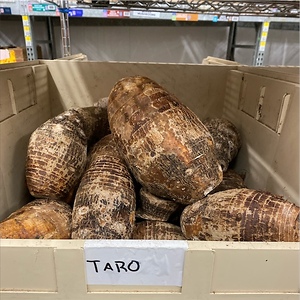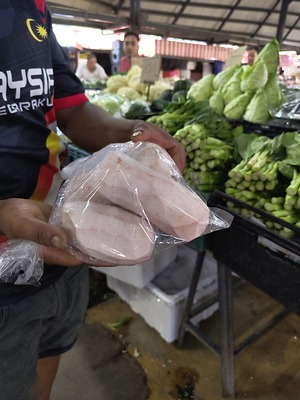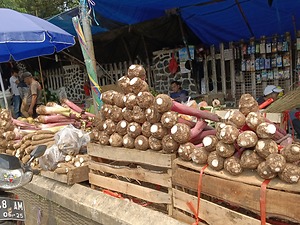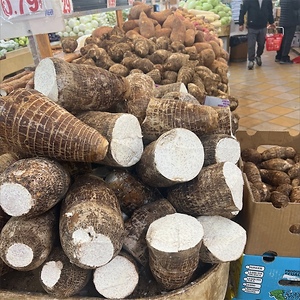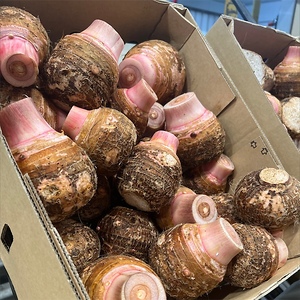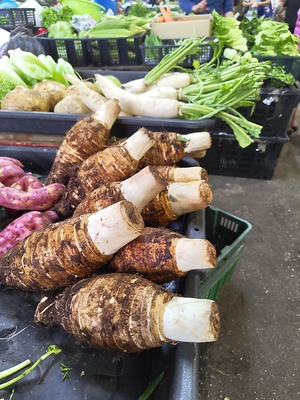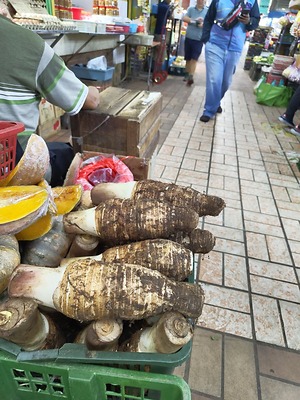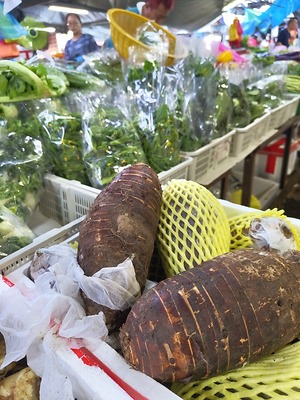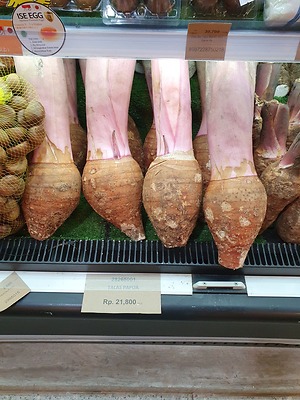


Big Taro Root
Estimated Inventory, 40 lbs : 5.20
This item was last sold on : 07/22/25
Description/Taste
Taro is a perennial tropical plant grown for its swollen roots, or corms, and its leafy vegetation. The plant rarely flowers or seeds and relies on the roots for propagation, which may reflect how long the Taro plant has been cultivated by humans. Replanting the upper portion of the root with the stem bud can create a whole new plant. The main root of the Taro plant is referred to as a ‘corm,’ which grows straight down into the ground and produces smaller “daughter corms” that branch off the main corm. It is similar to a potato in shape and look, with a dark brown flesh and noticeable growth rings. The skin can be smooth or slightly hairy depending on the variety. Its flesh can be stark white or cream colored with deep purple flecks. The flesh of the Taro root has a texture similar to a water chestnut and its flavor is mild and slightly nutty when cooked. Taro roots contain toxic calcium oxalate, which act like tiny pieces of glass, irritating the mouth and throat. This irritant is removed when the tuber is cooked.
Seasons/Availability
Big Taro root is available year-round.
Current Facts
Taro root is sometimes referred to as ‘the potato of the humid tropics’. It is botanically classified as Colocasia esculenta with eight recognized varieties including C. esculenta var. antiquorum and C. esculenta var. esculenta. Colocasia esculenta is the most commonly cultivated variety. The differences in varieties can either depend on the slight variances in the large, elephant ear-like leaves or in the size of the corms, or roots, below. In the Caribbean Taro is called Dasheen, in Egypt it’s called Culcas. The Japanese call the root Satoimo, and in Hawaii, where the Taro is revered, it is Kalo. In Africa, where the root is one of the main sources of carbohydrates and therefore energy, Taro is called Cocoyam.
Nutritional Value
Taro root has a better nutritional profile than both rice and potatoes, containing high amounts of iron, calcium, potassium, copper, manganese and dietary fiber. Taro root contains very high amounts of vitamin C, which makes the tuber a good source of immune system and antioxidant support.
Applications
Taro is a versatile root vegetable, but it cannot be eaten raw and MUST BE COOKED to remove the irritating calcium oxalate. In restaurants, Taro root is most commonly used to make chips, as a healthier alternative to a corn or potato chip. Despite the limited use in the United States, Taro has far more uses around the globe. Taro is a common kitchen ingredient in Thailand, Malaysia and India, and has a revered status in Hawaii. To prepare, use gloves to peel the Taro root to protect the hands from any irritants in the tuber. Using a knife, pare away the thick layer of rough skin. Unless making chips, the root must be boiled prior to being used and may require forty-five minutes to an hour. Once the root is cooked it can be mashed or pureed to be added to soups or a batter for Taro cake, even Taro smoothies. The boiled root can also be mashed and mixed with herbs to form vegan Taro burgers. To store, keep the unprepared Taro root in a cool pantry for up to two weeks. When stored in plastic in the refrigerator, it will keep longer.
Ethnic/Cultural Info
In Hawaii, Taro root is a vital part of cultural and agricultural traditions. When explorers landed on the islands, there were more than 300 recognized varieties of Taro. Although today, Taro shares its role as a staple with rice, potatoes, pasta, and bread, it remains an important crop to Hawaii. It is eaten principally as poi which is prepared by mashing the cooked root and creating a paste, that is either fermented or served immediately, typically with salted fish. It is also grown for lu'au, which in Hawaii is the term used for both the cooked leaves and the Hawaiian feast.
Geography/History
Taro is native to Southeast Asia and along with malanga or yautia may be one of the very first known cultivated vegetables. Its use dates back to ancient times, having been described as an important crop by both Greek and Roman historians. Taro is cultivated in swampy soils and flooded parcels along with rice and other semi-aquatic crops. It is also cultivated in drier conditions where it relies on rainfall and irrigation. Thought to have originated in the area of modern-day Malaysia, Taro root spread to tropical regions around the globe by explorers, west to Egypt and Africa and east to the Pacific Islands. Taro root is widely cultivated today in Hawaii, tropical Africa, and China. Over 10% of the world's population uses some variety of Taro as a food staple. It is highly regarded and used in cuisines throughout the world.
Featured Restaurants
Restaurants currently purchasing this product as an ingredient for their menu.
| Haru Holdings (Bun Section) | Carlsbad CA | 619-613-7909 |
| Leichtag Foundation | Encinitas CA | 760-230-6772 |
| Mission Pacific | Oceanside CA | 760-450-7864 |
| Coast Catering | Escondido CA | 619-295-3173 |
| Harmony Cuisine 2B1 | San Diego CA | 858-737-4777 |
| C 2 C | San Diego CA | 619-972-9345 |
| Viejas Casino Grove Steakhouse | Alpine CA | 800-295-3172 |
| Trust Restaurant | San Diego CA | 609-780-7572 |
| Blue Ocean Sushi & Grill (UTC) | San Diego CA | 858-886-9909 |
| InterContinental Vistal Kitchen | San Diego CA | 619-501-9400 |
| 333 Pacific | Oceanside CA | 760-433-3333 |
| Azuki Sushi Lounge | San Diego CA | 619-238-4760 |
| insideOUT | San Diego CA | 619-888-8623 |
| Corbeaux Wine & Tea House | Temecula CA | 909-567-6109 |
| Sovereign Thai Cuisine | San Diego CA | 619-887-2000 |
| Green Dragon Tavern & Museum | Carlsbad CA | 760-797-5579 |
| Paradisaea Restaurant | La Jolla CA | 732-915-6669 |
| Communion | San Diego CA | 619-606-5568 |
| Tom Hams Light House | San Diego CA | 619-291-9110 |
| The Joint | San Diego CA | 619-222-8272 |
| Del Mar Country Club | Rancho Santa Fe CA | 858-759-5995 |
| Rancho Valencia | Del Mar CA | 858-756-1123 |
| Choi's | San Diego CA | 858-900-1224 |
| Sago | Encinitas CA | 858-382-4047 |
| Craft House Fashion Valley | San Diego CA | 619-948-4458 |
| Bridges at Rancho Santa Fe | Rancho Santa Fe CA | 858-759-6063 |
| Continental Catering Inc | La Mesa CA | 907-738-9264 |
| Peohes | Coronado CA | 619-437-4474 |
| Books and Records | San Diego CA | 619-310-5298 |
| Common Theory | San Diego CA | 858-384-7974 |
| Barleymash | San Diego CA | 619-255-7373 |
| Stake Chophouse & Bar | Coronado CA | 619-522-0077 |
Recipe Ideas
Recipes that include Big Taro Root. One
| My Heart Beets |
|
Instant Pot Arbi (Taro Root) |







